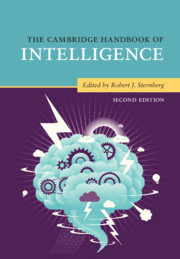Book contents
- The Cambridge Handbook of Intelligence
- The Cambridge Handbook of Intelligence
- Copyright page
- Dedication
- Contents
- Figures
- Tables
- Contributors
- Preface
- Part I Intelligence and Its Measurement
- 1 The Concept of Intelligence
- 2 A History of Research on Intelligence
- 3 A History of Research on Intelligence
- 4 An Alternative View on the Measurement of Intelligence and Its History
- 5 Factor-Analytic Models of Intelligence
- Part II Development of Intelligence
- Part III Intelligence and Group Differences
- Part IV Biology of Intelligence
- Part V Intelligence and Information Processing
- Part VI Kinds of Intelligence
- Part VII Intelligence and Its Role in Society
- Part VIII Intelligence and Allied Constructs
- Part IX Folk Conceptions of Intelligence
- Part X Conclusion
- Author Index
- Subject Index
- References
4 - An Alternative View on the Measurement of Intelligence and Its History
from Part I - Intelligence and Its Measurement
Published online by Cambridge University Press: 13 December 2019
- The Cambridge Handbook of Intelligence
- The Cambridge Handbook of Intelligence
- Copyright page
- Dedication
- Contents
- Figures
- Tables
- Contributors
- Preface
- Part I Intelligence and Its Measurement
- 1 The Concept of Intelligence
- 2 A History of Research on Intelligence
- 3 A History of Research on Intelligence
- 4 An Alternative View on the Measurement of Intelligence and Its History
- 5 Factor-Analytic Models of Intelligence
- Part II Development of Intelligence
- Part III Intelligence and Group Differences
- Part IV Biology of Intelligence
- Part V Intelligence and Information Processing
- Part VI Kinds of Intelligence
- Part VII Intelligence and Its Role in Society
- Part VIII Intelligence and Allied Constructs
- Part IX Folk Conceptions of Intelligence
- Part X Conclusion
- Author Index
- Subject Index
- References
Summary
IQ as a measure of intelligence is at the same time a success and a failure: a success because of the predictive value of IQ, and a failure because we do not know precisely what it is measuring. Intelligence has been defined in many ways. To discuss the definitional issue, we rely on Aristotle and his four ways to define something: explaining what it looks like, what it consists of, where it comes from, and what it is for. In this chapter we present an alternative view on how the measurement of intelligence has evolved and how it relates to different views on what intelligence is. The first initiatives to measure intelligence were inspired by physics and a strictly quantitative approach. These initiatives were based on the notion of general intelligence as mental energy, and led to tests to measure intelligence such as reaction times and perceptual discrimination (i.e., what intelligence looks like). IQ as a quantification of intelligence is from a later date and is based on a quite different type of test, inspired by an interest in what intelligence is for, as expressed in the work of some of the most famous intelligence test developers (e.g., Binet, Terman, Wechsler). The type of content of these tests is preserved in most intelligence tests today, mainly because of the predictive success of IQ tests. There now is also agreement that intelligence is not unitary but multidimensional. Robert Sternberg’s major endeavor to unravel processes has shown that there is no clear-cut answer to the question of what intelligence consists of in terms of cognitive processes or how processes can be measured. Other endeavors have resulted in measurement of genetic and environmental influences, in a revival of reaction time and discrimination measures, and in hypotheses about biological mechanics, such as mitochondrial efficiency. We conclude that intelligence is still a vague concept without much hope that it will be clarified soon, even though its measurement through a variety of cognitive tasks seems to work well from a predictive point of view.
Information
- Type
- Chapter
- Information
- The Cambridge Handbook of Intelligence , pp. 47 - 74Publisher: Cambridge University PressPrint publication year: 2020
References
Accessibility standard: Unknown
Why this information is here
This section outlines the accessibility features of this content - including support for screen readers, full keyboard navigation and high-contrast display options. This may not be relevant for you.Accessibility Information
- 2
- Cited by
